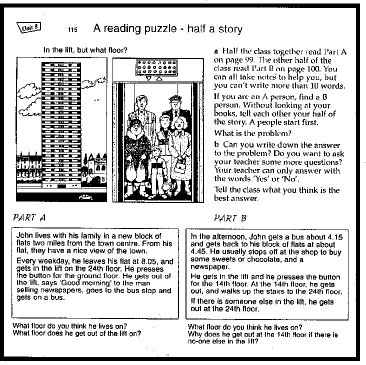Jigsaw reading
It was suggested earlier that getting students to rearrange in the correct order the jumbled paragraphs of a text was an effective way to promote global understanding of a new text. A useful extension of this preliminary activity, which also introduces a communicative element based on an information gap, is the 'jigsaw' text.
This can be employed with a range of texts, but one simple approach with a basic narrative is to distribute to each student in a group of, say, five, part of the story. Students must not show their section to anyone else. They then have to find, through discussion and exchange of information, the correct order for the story. With a well chosen text this can lead to prolonged and effective oral discussion.
Another approach is to set up a common task whose solution depends on obtaining information from all the parts of the text or all the other texts, if several different ones are being used. After considering their own passage and maybe answering a couple of questions on it to focus their attention on key aspects, students once again have to exchange information orally without looking at each other's texts until they have solved the common task. To keep things manageable, limit this to three texts or three sub-sections.
A good example of such a task, based on a classic brain teaser, can be found in the Collins Cobuild English Course:

Figure 8.4
An example of a jigsaw task
(From Willis and Willis, 1988)